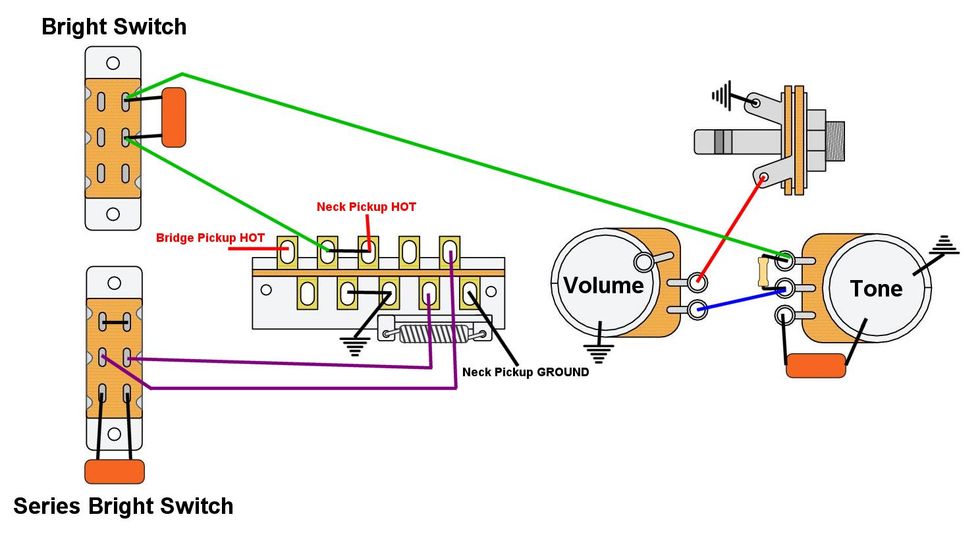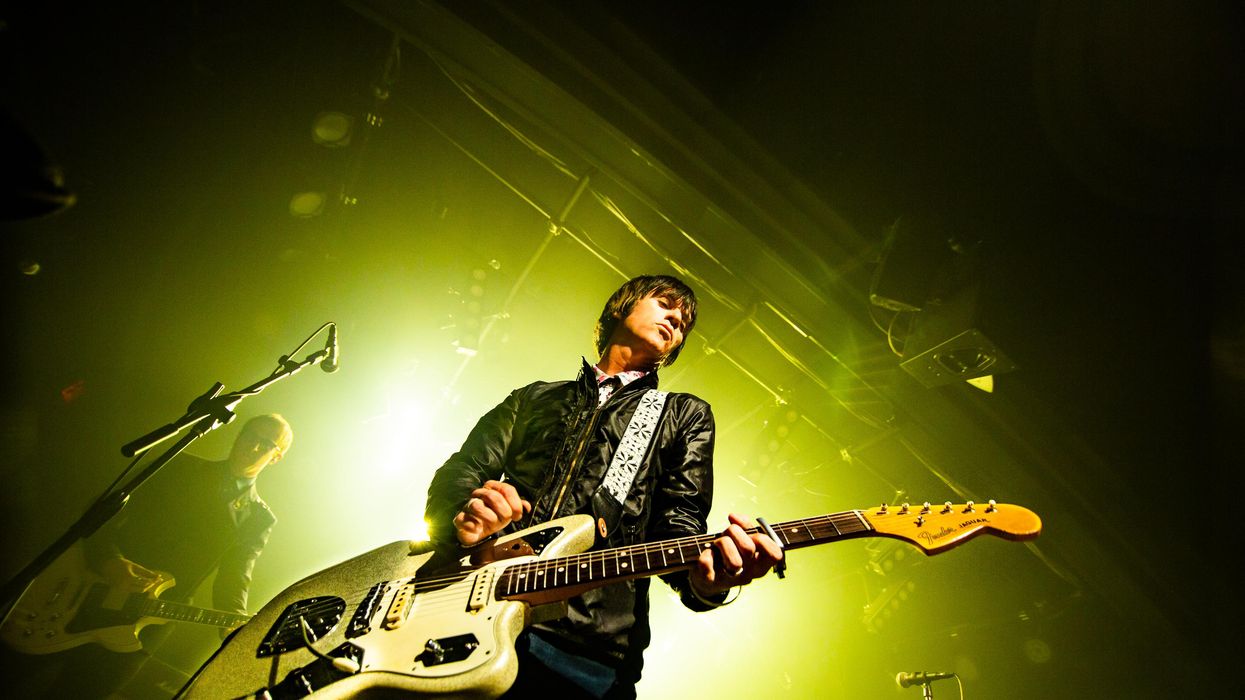Welcome back to Mod Garage. This month we’ll take a deeper look inside the Fender Jaguar and what can be done to its wiring to make it more practicable. The 1962 Fender Jaguar is one of the offset outlaw axes and we dipped into this subject some years before in “Mod Garage: Rewiring a Fender Jaguar.”
This time, we’ll focus mostly on the controls of the standard Jaguar, instead of focusing on the numerous switches and additional pots as I covered before. I’m always happy about receiving requests to write something about such guitars, as I really like these outlaw buddies and I don’t think they get the attention they should. So here we go.
Today we’ll dissect the Johnny Marr Jaguar wiring found in the Fender Johnny Marr signature Jaguar model. My PG colleague Charles Saufley recently did a great interview with Johnny Marr, so definitely read it if you want to find out more about him.
The U.K.-born Marr is best known as the guitarist and songwriter behind the Smiths, who redefined and ruled British pop in the 1980s. He’s also known for playing with The The, Modest Mouse, the Cribs, and, of course, his solo work as well as playing on countless sessions. Rolling Stone listed Marr at No. 51 of the 100 Greatest Guitarists and No. 67 on the 100 Greatest Songwriters of All Time. What else can one say?
Sound familiar? It is! The 4-way pickup switch is the 4-way switch from the series Telecaster wiring and the bright switch is the good old mid-tone cut switch (aka “strangle switch”) from the original Jaguar wiring but in a doubled version.
Marr started playing a Fender Jaguar around 2005 and used it during his stay with Modest Mouse, resulting in his signature model, released in 2012. The guitar and its wiring underwent several changes since then, and today we’ll talk about the actual version built by Fender (model #0116400705).
Regarding the electronics, you can spot the differences at first glance: Instead of the typical three switches on the lower-horn chrome plate, the Johnny Marr Jaguar sports a custom chrome plate with a Fender-style 4-position pickup selector switch. On the upper-horn chrome plate, the two additional pots were replaced with a second slide switch in a custom chrome plate, which sports two slide switches. In addition, the guitar has several hardware upgrades, custom-wound pickups, and the original master volume/master tone configuration.
Let’s look under the hood as to what these elements are doing on the Jaguar, here, in Fender’s own words:
Four-Way Pickup Switch: Rather than traditional slide switches, Marr’s signature Jaguar has a special four-way blade pickup switch on the lower horn, delivering the bridge pickup alone, the bridge and neck pickups in parallel, the neck pickup alone, and the neck and bridge pickups in series.
Two “Bright” Slide Switches: In an extra-special design element, the upper horn of the Johnny Marr Jaguar features two slide switches—a “universal” bright switch that kicks everything up a notch or two, and a separate bright switch that only affects the “series” pickup switch position.
Sound familiar? It is! The 4-way pickup switch is the 4-way switch from the series Telecaster wiring and the bright switch is the good old mid-tone cut switch (aka “strangle switch”) from the original Jaguar wiring, but in a doubled version.
In addition to this switching matrix, we find the typical vintage Jaguar master volume/master tone controls under the hood: two 1M audio pots with a 0.01 µF tone cap and a single 56k resistor on the tone pot.

Fig. 1
Before we dissect the wiring in Fig. 1, please note that it’s in an optical simplified version for a much better overview. The two switches are the typical Jaguar on/off switches—the ground of the bridge pickup is connected to common ground and not to the pickup-selector switch, same as for the Telecaster 4-way wiring.
Replacing the pickup switches with a standard pickup-selector switch not only makes operating the guitar a lot easier, but it enables an additional tone a standard Jaguar doesn’t have—both pickups together in series for a very fat and loud lead sound. It’s the same 4-way switch that you all know from the Electroswitch company (formerly Oak Grigsby) that’s used for the Telecaster. The downside of this mod is that you need a new custom chrome plate for the switch, but this type is available from several companies for a decent price. Fitting the switch can be a problem regarding the depth of the routing in the body. I’ve done this modification to several Jaguars, and in all cases I had to reroute the body to make it fit. It’s not a big deal with a good handheld router tool, but you should know about this problem. If you order a new Jaguar body, you should mention that you need a deeper routing at this location, so it’s a trouble-free operation.
Replacing the two additional pots with two switches on the upper horn also means that you need another new custom chrome plate, but this one is also available without any problems. The adaption of two individual strangle switches looks confusing, but, for whatever reason, Marr wants a general one influencing the whole wiring plus a special one only for the pickup position with both pickups in series. I can think of several applications for this wiring but it’s a matter of personal choice and preferences. If you have the playing chops of Marr, you’ll sound excellent with every guitar and every wiring inside. Us mere mortal pickers need some support from the wiring, so it’s no crime to mod it, but more about this later. In general, the bright or strangle switch uses a 3000 pF cap forming a fixed high-pass filter. In other words, it cuts bass, so the sound gets much brighter.
Using two 1M audio controls for master volume and master tone follows in the heritage of the Jaguar, same as for the single 56k resistor on the tone control together with the 0.01 µF tone cap. Nothing new here.
The combination of all this works, at least for Mr. Marr. But let’s break it down in sections.
The 4-way switch we all know from the Telecaster 4-way mod works perfectly and is a great addition to any guitar with two pickups, not only for a Jaguar. The switching order is the same as on the Telecaster (bridge only / bridge+neck in parallel / neck only / bridge+neck in series), so it feels like home. I don’t think there’s a useful variation for this mod: It’s perfect the way it is.
It’s up to you if you need a strangle switch, or if you need two of them. I think you should give it a try and play it for some time to see if you like it. Personally, I don’t need or like this feature, and in my own Jaguar I would use the two switches to add a kill-switch and phasing like we did with the Duo Sonic guitar in 2021. The series feature is already present in the Marr wiring, so the second switch would be my kill switch in this wiring. You can also tinker with the value of the bright caps on the two switches. Reasonable values would be from 1000 pF up to 6800 pF and everything in between. I think Marr’s concept behind the two switches was that he wanted to play a fat rhythm part without the bright switch, but when switching to solo mode (both pickups together in series) the sound gets very loud and fat and the dedicated bright switch helps to cut through the mix in this situation. So, it’s a kind of preset sound you can dial in—a concept that has tradition at the Fender company.
I really like 4700 pF on a Jaguar to dial in some fine nuances of warmth.
Regarding the two pots using 1M audio pots, this strictly follows the Jaguar vintage route and is boon and bane at the same time. The benefit is that with the pots fully opened, they’re close to a no-load pot with full high end. The downside is that in the Jaguar’s pure passive system the useable range of the pots is close to zero, acting like an on/off switch rather than a useful control with an effect over the whole rotation of the pot. Personally, I would change out both pots for two 250k audio pots or a 250k volume and 500k tone pot if you want a tad more high-end. The useable range is much better compared to the 1M pots, but this is also a matter of personal choice. Marr seems to like it, so it’s worth a try.
The standard volume control is perfect the way it is. I would add a treble-bleed network to keep some treble alive when rolling back the volume. For more info about this please have a look at “Mod Garage: Deep Diving into Treble-Bleed Networks.”
And last, the tone control. Choosing a 0.01 µF tone cap clearly shows the Jaguar was not designed for dark jazzy tones and that the tone should still have some good portion of treble when using the tone control. A 0.01 µF cap is a good choice, but if you need darker tones, go up to 0.015 or 0.022 µF and beyond. If 0.01 µF is still too dark for you, go down to 6800 pF and beyond. I really like 4700 pF on a Jaguar to dial in some fine nuances of warmth.
The 56k resistor on the tone control is a wired construction and there has been countless debates about it for decades. The physics behind it are very complex and I think Fender wanted to offer something new and versatile, but, as it often goes, the road to hell is paved with good intentions. Meaning, it works on the drawing board but not so good in reality. In very simplified words, it’s a mixture of limited tone control and a little bit of Gibson ’50s wiring. With the tone control fully opened, everything is normal and as you know it from other guitars like a Strat or Tele. When you start to close the tone pot, the 56k resistor is slowly pushed into the signal path, forming a low pass together with the 0.01 µF cap, resulting in attenuating the tone and the resonance peak. With the tone pot fully closed, it acts like a ’50s wiring and there is no resonance shift.
It’s not a bad design per se—some like it while others don’t. An interesting detail is that when you start to close the tone pot, the pickup’s inductance will be decoupled from the cable capacitance, resulting in a glassy and ice-picking tone, and I think this was exactly what the Fender designers had in mind. In reality, this effect is completely offset because of the following high-end roll-off caused by the guitar electronics. Maybe Fender wanted to try something new, putting as many tonal features as possible into the Jaguar. It shall remain a secret and a mystery.
I would remove the resistor and rewire volume and tone as in a standard Telecaster for a traditional control. Give it a try and see if you like the Jaguar method better. Who knows? You can also experiment with the 56k resistor; reasonable values are from 22k up to 100k.
That’s it for now! Next month we’ll cover something you’ve asked for a lot: a mod for both electric and acoustic guitars to enhance tuning stability.
Until then ... keep on modding!






































